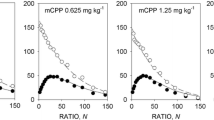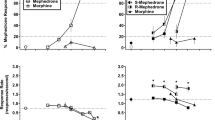Abstract
Twelve rats received injections of 5,7-dihydroxytryptamine into the dorsal and median raphe nuclei; 12 rats received sham lesions. The rats were then trained for 60 sessions under a discrete-trials fixed-interval schedule (peak procedure). In half the trials, a reinforcer became available 40 s after trial onset, and the trial was terminated upon reinforcer delivery; the remaining trials were 120 s in duration, and reinforcement did not occur in these trials. Performance during the 120-s trials was characterized by increasing response rate during the first 40 s of the trial, declining response rate between 40 s and 80 s, and a secondary increase in response rate during the final 40 s of the trial. The lesioned group showed a broader “spread” of the response rate function than the control group (time between attainment of 70% of the peak response rate and subsequent decline of response rate below this level); however, the peak response rate and the time from trial onset until attainment of the peak response rate did not differ significantly between the groups; the spread/peak-time ratio was significantly greater in the lesioned group than in the control group. The levels of 5-hydroxytryptamine (5HT) and 5-hydroxyindoleacetic acid in the parietal cortex, hippocampus, amygdala, nucleus accumbens and hypothalamus were markedly reduced in the lesioned group, but the levels of noradrenaline and dopamine were not significantly affected by the lesion. The results confirm the involvement of 5HTergic function in timing behaviour.
Similar content being viewed by others
References
Altman HG, Normile HJ (1988) What is the nature of the role of the serotonergic nervous system in learning and memory; prospects for development of an effective treatment strategy for senile dementia. Neurobiol Aging 9:627–638
Altman HJ, Normile HJ, Galloway MP, Ramirez A, Azmitia EC (1990) Enhanced spatial discrimination learning in rats following 5,7-DHT-induced serotonergic deafferentation of the hippocampus. Brain Res 518:61–66
Asin KE, Fibiger HC (1984) Spontaneous and delayed spatial alternation following damage to specific neuronal elements within the nucleus medianum raphe. Behav Brain Res 13:241–250
Baumgarten HG, Jenner S, Bjorklund A, Klemm HP, Schossberger HG (1982) Serotonin neurotoxins. In: Osborn NN (ed) Biology of serotonergic transmission. Wiley, Chichester
Catania AC (1970) Reinforcement schedules and psychophysical judgements: a study of some temporal properties of behavior. In: Schoenfeld WN (ed) The theory of reinforcement schedules. Appleton-Century-Crofts, New York
Chatlosh DL, Wassermann EA (1987) Delayed temporal discrimination in pigeons: a comparison of two procedures. J Exp Anal Behav 47:299–309
Church RM, Deluty MZ (1977) Bisection of temporal intervals. J Exp Psychol: Anim Behav Proc 3:216–228
Church RM, Miller KD, Meck WH, Gibbon J (1991) Symmetrical and asymmetrical sources of variance in temporal generalization. Anim Learn Behav 19:207–214
Deakin JFW (1983) Roles of serotonergic systems in escape, avoidance and other behaviours. In: Cooper SJ (ed) Theory in psychopharmacology, vol 2. Academic Press, New York
Gibbon J (1977) Scalar expectancy theory and Weber's law in animal timing. Psychol Rev 84:279–325
Gibbon J (1991) Origins of scalar timing. Learn Motiv 22:3–38
Gibbon J, Church RM (1984) Sources of variance in an information processing theory of timing. In: Roitblat HL, Bever TG, Terrace HS (ed) Animal cognition. Erlbaum, Hillsdale, N.J.
Gibbon J, Church RM (1990) Representation of time. Cognition 37:23–54
Gibbon J, Church RM (1992) Comparison of variance and covariance patterns in parallel and serial theories of timing. J Exp Anal Behav 57:393–406
Gibbon J, Church RM, Meck WH (1984) Scalar timing in memory. In: Gibbon J, Allan L (ed) Timing and time perception Ann NY Acad Sci 423:52–77
Heffner TG, Hartman JA, Seiden LS (1980) A method for the regional dissection of the rat brain. Pharmacol Biochem Behav 13:453–456
Killeen PR, Fetterman JC (1988) A behavioral theory of timing. Psychol Rev 95:274–295
Killeen PR, Fetterman JG (1993) The behavioral theory of timing: transition analyses. J Exp Anal Behav 59:411–422
MacEwen D, Killeen PR (1991) The effect of rate and amount of reinforcement on the speed of the pacemaker in pigeons' timing behavior. Anim Learn Behav 19:164–170
Meck WH, Angell KE (1992) Repeated administration of pyrithiamine leads to a proportional increase in the remembered durations of events. Psychobiology 20:39–46
Meck WH, Church RM (1987a) Cholinergic modulation of the content of temporal memory. Behav Neurosci 101:457–464
Meck WH, Church RM (1987b) Nutrients that modify the speed of internal clock and memory storage processes. Behav Neurosci 101:465–475
Meck WH, Church RM, Olton DS (1984) Hippocampus, time and memory. Behav Neurosci 98:3–22
Morrissey G, Wogar MA, Bradshaw CM, Szabadi E (1993) Effect of lesions of the ascending 5-hydroxytryptaminergic pathways on timing behaviour investigated with an interval bisection task. Psychopharmacology 112:80–85
Roberts S (1981) Isolation of an internal clock. J Exp Psychol [Anim Behav Proc] 7:242–268
Wearden JH, McShane B (1988) Interval production as an analogue of the peak procedure: evidence for similarity of human and animal timing processes. Q J Exp Psychol 44B:363–376
Wogar MA, Bradshaw CM, Szabadi E (1991) Evidence for an involvement of 5-hydroxytryptaminergic neurones in the maintenance of operant behaviour by positive reinforcement. Psychopharmacology 105:119–124
Wogar MA, Bradshaw CM, Szabadi E (1992) Impaired acquisition of temporal differentiation performance following lesions of the ascending 5-hydroxytryptaminergic pathways. Psychopharmacology 107:373–378
Wogar MA, Bradshaw CM, Szabadi E (1993a) Effects of lesions of the ascending 5-hydroxytryptaminergic pathways on choice between delayed reinforcers. Psychopharmacology 111:239–243
Wogar MA, Bradshaw CM, Szabadi E (1993b) Does the effect of central 5-hydroxytryptamine depletion on timing depend on motivational change? Psychopharmacology 112:86–92
Zeiler MD (1977) Schedules of reinforcement, the controlling variables. In: Honig WK, Staddon JER (eds) Handbook of operant behavior. Prentice Hall, Englewood Cliffs, N.J.
Author information
Authors and Affiliations
Rights and permissions
About this article
Cite this article
Morrissey, G., Ho, M.Y., Wogar, M.A. et al. Effect of lesions of the ascending 5-hydroxytryptaminergic pathways on timing behaviour investigated with the fixed-interval peak procedure. Psychopharmacology 114, 463–468 (1994). https://doi.org/10.1007/BF02249337
Received:
Revised:
Issue Date:
DOI: https://doi.org/10.1007/BF02249337




